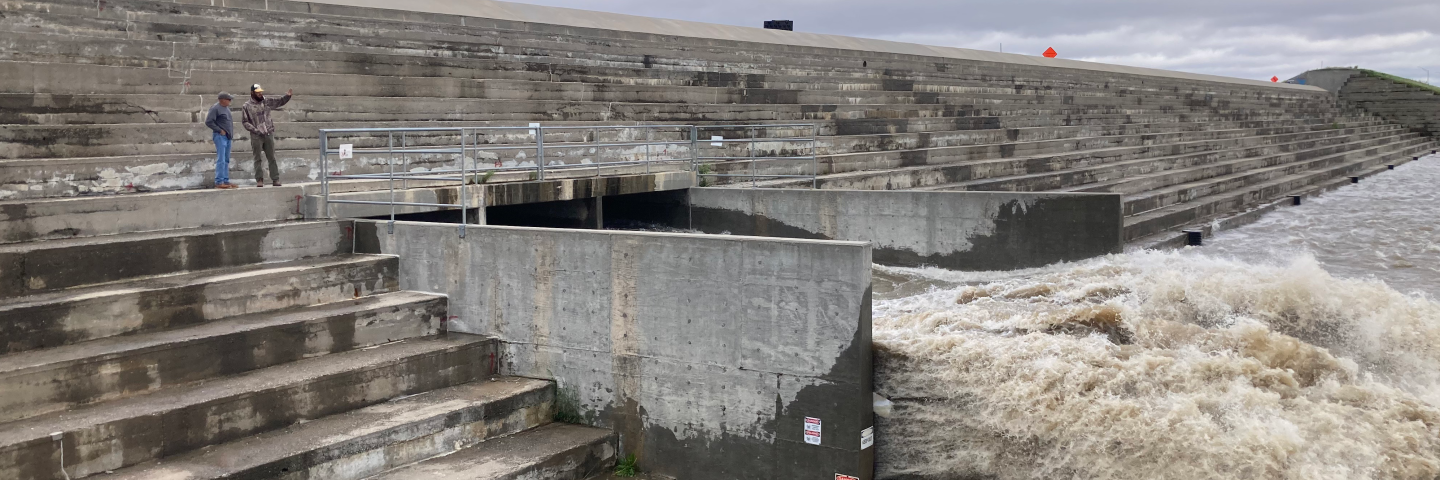NRCS Dams Time and Weather Tested

Dams are designed to save lives and protect property downstream especially during torrential unimpeded rain—the kind that causes intense flash flooding. These extreme events put watershed dams to the test, like the May 21 rainstorm that delivered 10 inches of rain to eastern Nebraska.
Allen Gehring, P.E., the state engineer with USDA’s Natural Resources Conservation Service (NRCS) in Nebraska, was already on alert having received a monitoring message from DamWatch, a web-based tool that helps NRCS staff and dam owners to predict and prepare for potentially destructive weather events. “Eighteen watershed dams received DamWatch threshold rainfall alerts. Sponsors, NRCS staff (State, Area and Field) and Nebraska dam safety agency personnel visited all 18 sites in person within hours following the event,” said Gehring. “Everyone was pleased with the way the structures worked considering that some dams [are] 40-50 years old. It was no surprise they all performed admirably when put to the test because the sponsors have and continue to do a stellar job of maintaining these structures.”
No damage or erosion was observed are words that sound like poetry to a conservation engineer, after rain clouds pass and water levels lower at a watershed dam. Solving watershed resource concerns through proven science and design…is the job. Seeing dams perform as intended is the high-five adrenaline rush that keeps engineers like Gehring committed to the NRCS mission of locally-led conservation efforts. Within the lifespan of these structures, sponsors shared that this was the first-time they had seen auxiliary spillway flow on the structures (pictured above). Auxiliary spillways, by design, provide an additional outlet when the primary outlet exceeds its capacity during heavy rainstorm events.
These dams, built through the UNRCS Watershed Program in partnership with Nebraska’s Natural Resources Districts (NRDs), proved their worth during this extreme weather event.
Benefits of Dams
Within the 51,000-acre Bellwood Creek Watershed, 13 dams south of Bellwood, Nebraska, in Butler County, prevented an estimated $ one million in damages to downstream property and infrastructure. The Lower Platte North NRD is responsible for the operation and maintenance of these 13 structures.
Similarly, the 34,000-acre Cottonwood Creek sub-watershed, northwest of Wahoo, Nebraska, in Saunders County, benefitted from 12 dams that prevented an estimated $300,000 in damages. Despite these protective measures, the town of Wahoo still experienced significant flooding. However, the dams helped reduce the overall impact. The towns of Prague and Malmo also saw benefits from these dams. The Lower Platte North NRD manages these structures.
In the 63,000-acre North Oak sub-watershed, spanning portions of Butler, Saunders, and Lancaster Counties, 16 dams prevented an estimated $800,000 in property and infrastructure damage. The towns of Valparaiso and Raymond are located within this watershed. The Lower Platte South NRD oversees the maintenance of these dams.
The performance of these watershed structures is a proud accomplishment for NRCS, Nebraska’s Natural Resources Districts and stakeholders.
Building Resilience
Looking towards the future, NRCS is working with the local Wahoo Creek Watershed NRD to provide funding for the construction of nine floodwater-retention dams.
“This project provides a critical link in continuing efforts to reduce flood damage along the Wahoo Creek Watershed,” said Eric Gottshalk, Lower Platte North NRD general manager. “While we understand we will never be able to control all of the flooding, we continue to work hard to reduce the risk throughout our 1-million-acre district. After many years of planning, it is satisfying to see all components coming together.”
The Nebraska Association of Resources Districts (NARD), the trade association for Nebraska's 23 Natural Resources Districts (NRD), works with individual districts to protect lives, property, and the future of Nebraska’s natural resources. NRDs are unique to Nebraska, and act as local government entities with broad responsibilities to protect Nebraska’s natural resources. Major Nebraska river basins form the boundaries of the 23 NRDs, enabling districts to respond to local conservation and resource management needs. Learn more about Nebraska’s NRDs at www.nrdnet.org.

